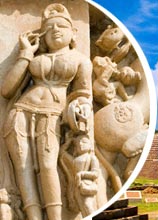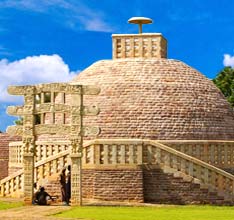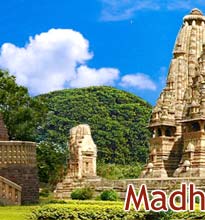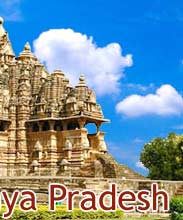A place endowed with red sandstone hills and
emerald-green forests, Pachmarhi boasts of being the only hill resort of
the largest state of India. An exclusive colonial retreat during the
bygone era; the place today embraces tourists from every alcove of the
country. With its towering peaks, green glades and deep gorges, the
beauty of this hill resort remains enviable. The colonial architectural
splendors, embedded in its blessed landscape, make the place even more
inviting. This article will help you explore the tourist attractions of
Pachmarhi and give you a glimpse of the various places to be seen there.
Pandava
Caves
An important tourist landmark in Panchmarhi, Pandav Caves lend their
name to this picturesque hill resort of Madhya Pradesh. According to
local legends and popular beliefs, the five Pandav brothers of
Mahabharata, along with their wife 'Draupadi', spent a part of their
exile here.
Catholic Church
Built by the British in 1892, this ancient monument displays a striking
blend of French and Irish architecture. The stained glass windows
beautify the edifice and add to its magnificence. It also has an old
cemetery attached to it. The tombstones here dates back to 1859, World
War I and World War II.
Christ Church
The British built this church in 1875. Considered as the most stunning
small church in Madhya Pradesh, the building displays an artistic
architectural style. It has a hemispherical dome on top of its
'sanctum-sanctorum'. The tinted glass panes gilded on the walls and the
altar present dazzling views as sunrays pass.
Priyadarshini Point
Earlier known as Forsyth Point, it was named after Captain James
Forsyth who discovered Panchmarhi from this point. Witnessing the
spectacular sunset views from this vantage point, when the three peaks -
Chauradeo, Mahadeo and Dhupgarh, play with various hues, is a privileged
sight.
Jatasankar
A sacred cavern under a mass of loose boulders, the place is named
'Jatasankar', as a rock formation here resembles the tangled manes of
Lord Shiva. The 'Samadhistha Shiva' in this dark cave resembles the hood
of a serpent and is a site of awe and reverence.
Apsara Vihar (Fairy Pool)
This pool is located near the Pandava caves and is accessible only on
foot. A waterfall plummets from a height of 30 ft to form this pool. The
water gets deeper as it nears the fall, but the shallow ends of the pool
remains ideal for swimming and diving. Tourists flock to this place to
take refreshing dips in the mountain water.
Handi Khoh
Earlier known as 'Andhi Kho' amongst the natives, it is the deepest of
all the gorges at Pachmarhi and is nearly 300 ft deep. It is shadowed in
a wild thicket, with dramatically steep sides. According to legends,
Shiva imprisoned a large snake, which actually was a demon, and buried
it in a solid rock in this ravine
Rajat Prapat (Big Fall)
A ten-minute walk from Apsara Vihar leads to the top of Rajat Pratap,
the Big Fall. This fall is nearly 350 ft in height. It is a thrilling
experience to watch straight down into the bottom of the fall, as it
cascades its way from the high precipice. The journey that leads to the
fall is bliss for the adventure-seekers.
Mahadeo
Coppices of Sal trees and precarious hairpin bends lead to the cave
shrine of Mahadeo. Drops of water trickle from the roof of this cave and
form a holy pool in which the devotees can take a dip. The large
'shivling' of this shrine is the main site of worship. Pilgrims flock to
the place, especially during 'Shivratri'.
Jalawataran (Duchess Fall)
The most beautiful of all Pachmarhi falls, it can be reached only on
foot. The descent to the fall is steep and the journey is quite arduous.
This fall plunges down in three different cascades, accompanied by
deafening sounds. No doubt, the alluring sight and sound of the place
makes it a hot spot amongst tourists.









